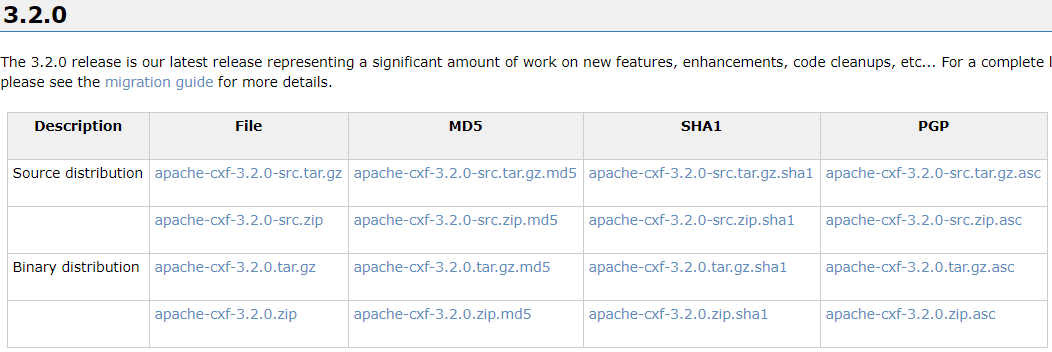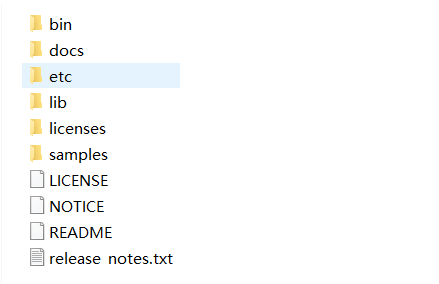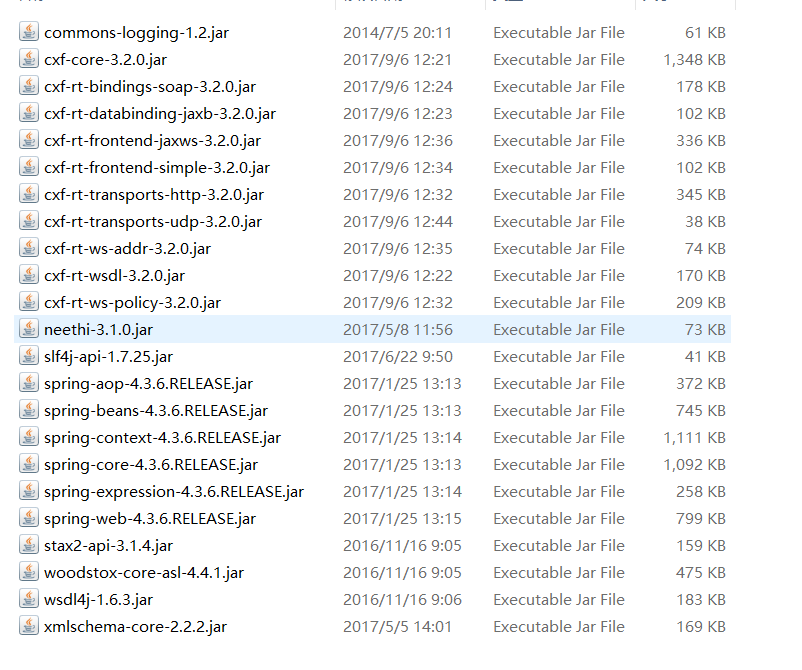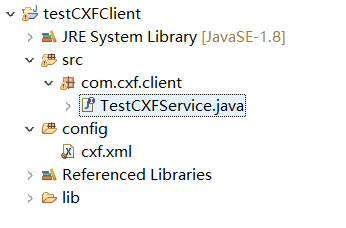Apache CXF入门
CXF简介
Apache CXF = Celtix + XFire,开始叫 Apache CeltiXfire,后来更名为 Apache CXF 了。CXF 继承了 Celtix 和 XFire 两大开源项目的精华,提供了对 JAX-WS 全面的支持,并且提供了多种 Binding 、DataBinding、Transport 以及各种 Format 的支持,并且可以根据实际项目的需要,采用代码优先(Code First)或者 WSDL 优先(WSDL First)来轻松地实现 Web Services 的发布和使用。Apache CXF已经是一个正式的Apache顶级项目。
Apache CXF 是一个开源的 Services 框架,CXF 帮助您利用 Frontend 编程 API 来构建和开发 Services ,像 JAX-WS 。这些 Services 可以支持多种协议,比如:SOAP、XML/HTTP、RESTful HTTP 或者 CORBA ,并且可以在多种传输协议上运行,比如:HTTP、JMS 或者 JBI,CXF 大大简化了 Services 的创建,同时它继承了 XFire 传统,一样可以天然地和 Spring 进行无缝集成。
CXF优点
(1)支持多种协议:
SOAP1.1,1.2
XML/HTTP
CORBA(Common Object Request Broker Architecture公共对象请求代理体系结构,早期语言使用的WS。C,c++,C#)
(2)可以与Spring进行快速无缝的整合
(3)灵活的部署:可以运行在Tomcat,Jboss,Jetty(内置),IBMWS,BeaWL上面。
看这个之前可以看看关于WebService的文章:链接http://www.cnblogs.com/xiaobai1226/p/7543965.html
接下来就开始写一个CXF的简单入门程序
一、服务端程序
首先去官网下载jar包
官方下载网址:http://cxf.apache.org/download.html
进入此页面后,会看到此页面

下载好后会看到这样一个压缩文件:
解压后,有这些目录文件

下面简单介绍一下这些目录以及里面文件的作用
(1)bin:是 CXF 框架中所提供的代码生成、校验、管理控制台工具:
(2)docs:CXF 所有类(class)对应的 API 文档,为开发者使用 CXF 完成应用开发提供应有的帮助。
(3)etc:包含一个基本的 Service 暴露所需要的 web.xml 文件,及其它的配置文件。
(4)lib:目录中包含 CXF 及其运行时所需要的和可选的第三方支持类包(.jar 文件),可以根据不同项目所需的 CXF 特性选择所需要的支持类包。
(5)licenses:列表了引用第三方 jar 包的相关许可协议。
(6)samples:samples 目录中包含了所有随 CXF 二进制包发布的示例,包含这些示例的源代码和相关 Web 应用配置文件,可以方便地用 Ant 来编译运行测试这些示例,来了解 CXF 的开发和使用的方法。可以通过 samples 目录和它各个子目录下的 README.txt 的文件来详细了解示例的编译与运行的步骤。
(7)LICENSE :文件中包含了 CXF 框架的授权协议 Apache License Version 2.0 。
(8)NOTICE :罗列了 CXF 框架用到的相关第三方组件的授权协议以其它的相关信息。
(9)README :文件中包含了 CXF 框架本身的一些简要说明。
(10)release_notes.txt :包含了 CXF 发布时的一些信息,包括运行时所需要的环境,修复 BUG 的列表等。
接下来,第一步:创建动态web项目
第二步:导入CXF相关jar包,以下jar包是使用CXF所必须的jar包(CXF能运行起来最基本的jar包)

第三步:在web.xml中配置CXF框架提供的一个Servlet
<!-- 配置CXF框架提供的Servlet --> <servlet> <servlet-name>cxf</servlet-name> <servlet-class>org.apache.cxf.transport.servlet.CXFServlet</servlet-class> <!-- 通过初始化参数指定CXF框架的配置文件位置 --> <init-param> <param-name>config-location</param-name> <param-value>classpath:cxf.xml</param-value> </init-param> </servlet> <servlet-mapping> <servlet-name>cxf</servlet-name> <url-pattern>/service/*</url-pattern> </servlet-mapping>
第四步:在类路径下提供cxf.xml
<?xml version="1.0" encoding="UTF-8"?> <beans xmlns="http://www.springframework.org/schema/beans" xmlns:xsi="http://www.w3.org/2001/XMLSchema-instance" xmlns:jaxws="http://cxf.apache.org/jaxws" xmlns:soap="http://cxf.apache.org/bindings/soap" xsi:schemaLocation="http://www.springframework.org/schema/beans http://www.springframework.org/schema/beans/spring-beans.xsd http://cxf.apache.org/bindings/soap http://cxf.apache.org/schemas/configuration/soap.xsd http://cxf.apache.org/jaxws http://cxf.apache.org/schemas/jaxws.xsd"> </beans>
第五步:开发一个接口和实现类
接口,接口上必须使用@WebService实现类(jdk1.6及以后才支持@WebService注解,所以要确保jdk版本够高)
import javax.jws.WebService; @WebService public interface TestCXFService { public String firstCXF(String name); }
实现类
public class TestCXFServiceImpl implements TestCXFService{ @Override public String firstCXF(String name) { System.out.println("基于CXF开发的服务端firstCXF被调用了"); return "Hello "+name; } }
第六步:在cxf.xml中注册服务
<bean id="firstCXFService" class="com.cxf.service.impl.TestCXFServiceImpl"/> <!-- 注册服务 --> <jaxws:server id="myCXFService" address="/cxfService"> <jaxws:serviceBean> <ref bean="firstCXFService"/> </jaxws:serviceBean> </jaxws:server>
到现在,使用CXF配置的服务就配置成功了
接下来,启动tomcat,在浏览器访问这个地址:http://localhost:8080/testCXF/service/cxfService?wsdl
http://配置此服务的服务器ip地址 / 端口 / 你所创建的工程的名称 / 自己在web.xml配置的路径 / 自己配置的address?wsdl 注意:(1)由于我使用tomcat所以端口号为8080 (2)<url-pattern>/service/*</url-pattern>(3)address="/cxfService"
若出现这个页面说明成功了
This XML file does not appear to have any style information associated with it. The document tree is shown below. <wsdl:definitions xmlns:xsd="http://www.w3.org/2001/XMLSchema" xmlns:wsdl="http://schemas.xmlsoap.org/wsdl/" xmlns:tns="http://impl.service.cxf.com/" xmlns:soap="http://schemas.xmlsoap.org/wsdl/soap/" xmlns:ns2="http://schemas.xmlsoap.org/soap/http" xmlns:ns1="http://service.cxf.com/" name="TestCXFServiceImplService" targetNamespace="http://impl.service.cxf.com/"> <wsdl:import location="http://localhost:8080/testCXF/service/cxfService?wsdl=TestCXFService.wsdl" namespace="http://service.cxf.com/"></wsdl:import> <wsdl:binding name="TestCXFServiceImplServiceSoapBinding" type="ns1:TestCXFService"> <soap:binding style="document" transport="http://schemas.xmlsoap.org/soap/http"/> <wsdl:operation name="firstCXF"> <soap:operation soapAction="" style="document"/> <wsdl:input name="firstCXF"> <soap:body use="literal"/> </wsdl:input> <wsdl:output name="firstCXFResponse"> <soap:body use="literal"/> </wsdl:output> </wsdl:operation> </wsdl:binding> <wsdl:service name="TestCXFServiceImplService"> <wsdl:port binding="tns:TestCXFServiceImplServiceSoapBinding" name="TestCXFServiceImplPort"> <soap:address location="http://localhost:8080/testCXF/service/cxfService"/> </wsdl:port> </wsdl:service> </wsdl:definitions>
二、客户端程序
有两种方式:方式一:使用jdk提供的wsimport命令生成本地代码完成调用(另一篇介绍webservice的文章中有使用,链接在文章开头给出了,在这里不再使用)
方式二:使用CXF提供的方式(我们使用第二种方式)
第一步:创建Java项目并导入CXF相关jar包 (jar包同上)
第二步:使用wsimport或者CXF提供wsdl2java生成本地代码,只需要生成接口文件
打开cmd进入CXF文件夹的bin目录下(如apache-cxf-3.2.0\bin),输入
wsdl2java -d . -p com.cxf.client http://localhost:8080/testCXF/service/cxfService?wsdl
.代表将生成的文件放到当前目录下,-p代表生成的目录结构,最后的地址代表根据哪个wsdl生成文件
敲回车,出现以下结果,和方式一不同这个成功后,没有任何提示

这时就发现,当前目录下出现了这个文件夹

打开后,有以下目录文件,而我们只需要用到一个接口文件(红框标出来的)

第三步:将接口文件复制到项目中

复制过来后,我们需要将红框内内容删掉,因为我们只把一个接口文件复制过来了,其他的并没有动,所以找不到这个文件,而我们又用不到,所以直接删掉就好 
删除后接口内代码是这样的
package com.cxf.client; import javax.jws.WebMethod; import javax.jws.WebParam; import javax.jws.WebResult; import javax.jws.WebService; import javax.xml.bind.annotation.XmlSeeAlso; import javax.xml.ws.RequestWrapper; import javax.xml.ws.ResponseWrapper; /** * This class was generated by Apache CXF 3.2.0 * 2017-09-24T12:35:54.073+08:00 * Generated source version: 3.2.0 * */ @WebService(targetNamespace = "http://service.cxf.com/", name = "TestCXFService") @XmlSeeAlso({}) public interface TestCXFService { @WebMethod @RequestWrapper(localName = "firstCXF", targetNamespace = "http://service.cxf.com/", className = "com.cxf.client.FirstCXF") @ResponseWrapper(localName = "firstCXFResponse", targetNamespace = "http://service.cxf.com/", className = "com.cxf.client.FirstCXFResponse") @WebResult(name = "return", targetNamespace = "") public java.lang.String firstCXF( @WebParam(name = "arg0", targetNamespace = "") java.lang.String arg0 ); }
第四步:提供spring配置文件,注册客户端代理对象
<?xml version="1.0" encoding="UTF-8"?> <beans xmlns="http://www.springframework.org/schema/beans" xmlns:xsi="http://www.w3.org/2001/XMLSchema-instance" xmlns:jaxws="http://cxf.apache.org/jaxws" xmlns:soap="http://cxf.apache.org/bindings/soap" xsi:schemaLocation="http://www.springframework.org/schema/beans http://www.springframework.org/schema/beans/spring-beans.xsd http://cxf.apache.org/bindings/soap http://cxf.apache.org/schemas/configuration/soap.xsd http://cxf.apache.org/jaxws http://cxf.apache.org/schemas/jaxws.xsd"> <!-- 注册CXF客户端代理对象,通过spring框架创建这个代理对象,使用代理对象实现远程调用 --> <jaxws:client id="myCXFClient" address="http://localhost:8080/testCXF/service/cxfService" serviceClass="com.cxf.client.TestCXFService"> </jaxws:client> </beans>
第五步:写一个测试类,读取spring配置文件,创建spring工厂,从工厂中获取代理对象,实现远程调用
package com.cxf.client; import org.springframework.context.ApplicationContext; import org.springframework.context.support.ClassPathXmlApplicationContext; public class TestCXFClient { public static void main(String[] args) { ApplicationContext ctx = new ClassPathXmlApplicationContext("classpath:cxf.xml"); TestCXFService proxy = (TestCXFService) ctx.getBean("myCXFClient"); String result = proxy.firstCXF("my first CXFClient"); System.out.println(result); } }
执行main方法(此时要确保服务端启动着),出现以下结果,就证明程序运行成功了
客户端控制台打印

服务端控制台打印

到现在,CXF入门程序就完成了。



